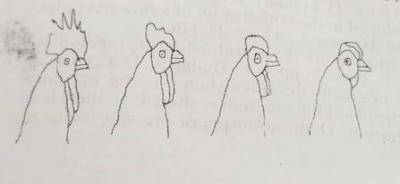
The diagrams above are illustrations of types of comb found in domestic fowl. Study them and answer this question.
Which factor is most likely responsible for the various types of comb?
- A. environment
- B. genetics
- C. physiology
- D. morphology
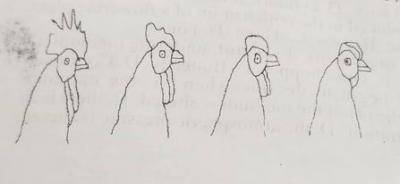
The diagrams above are illustrations of types of comb found in domestic fowl. Study them and answer this question.
The types of comb show ?
- A. variation
- B. inheritance
- C. cell theory
- D. courtship behaviour
Which of the following resources cannot be conserved?
- A. forest
- B. water
- C. soil
- D. garbage
Which of the following practices is a wildlife conservation method?
- A. use of cover crops
- B. crop rotation
- C. mulching
- D. discouraging poaching
Endangered species are organisms that are?
- A. likely to migrate to other favourable lands
- B. likely to disappear from the surface of the earth
- C. reproducing profusely in an area
- D. dangerous to humans and attacking other animals
Which of the following behaviours is correctly matched with the corresponding diseases?
- A. Smoking cigarette / Liver cirrhosis. Lung cancer, AIDS
- B. Having multiple sexual partners / liver cirrhosis, syphilis, AIDS.
- C. Living near dirty gutter / Lung cancer, syphilis, river blindness.
- D. Eating uncooked meatf/fdysentery, cholera. food poisoning.
When a large number of organisms share limited resources, the result is?
- A. mutualism
- B. extinction
- C. commensalism
- D. competition
An association between living organisms in which one organism lives on and feeds at the expense of the other organism is known as?
- A. mutualism
- B. commensalism
- C. parasitism
- D. predation
Which of the following features is a characteristic of aquatic plants possession of ?
- A. multiple epidermis
- B. heavily lignified tissue
- C. finely divided leaves
- D. succulent stem
The illustration below is a food chain.
Grass→grasshopper→domestic fowl→hawk
What would happen if the population of domestic fowl decreases?
- A. grasshoppers would decrease
- B. hawks would increase
- C. grasshoppers would increase
- D. grasses available to grasshoppers
Rabbits cannot survive in an aquatic habitat because they have
- A. no scales
- B. no gills
- C. fore limbs
- D. lateral line
Plants and animals of an ecosystem make up a?
- A. habitat
- B. succession
- C. community
- D. population
The following organisms are examples of carnivorous plants except.
- A. gloriosa
- B. venus flytrap
- C. pitcher plant
- D. Utricularia
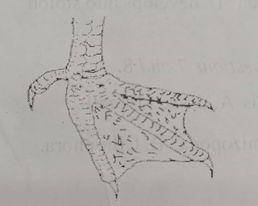
The diagram above is an illustration of the foot of an animal.
The adaptation of this type of foot is that it is?
- A. used as a bait to catch fish in water
- B. used as a paddle for swimming
- C. effective in scratching the soil for food
- D. used for killing prey in water
The process that takes place at the light stage of photosynthesis is?
- A. splitting of water molecules to form hydrogen ions
- B. reduction of carbon (IV) oxide to form carbohydrate
- C. formation of two molecules of phosphoglyceric acid
- D. breaking down of ATP molecules to produce energy
Autotrophic nutrition is a process whereby an organism obtains food
- A. by utilizing its store energy
- B. by synthesizing simple substances using energy
- C. from other organisms in exchange for some products
- D. in a synthesized form, from other living organisms
Which of the following factors is not necessary for photosynthesis?
- A. water
- B. carbon (IV) oxide
- C. wind
- D. sunlight
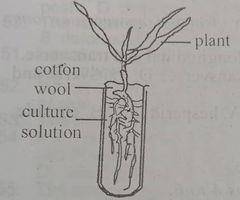
The diagram above is an illustration of the growth of a plant in a water culture. After a few days, the solution turned green and the plant died. Use this to answer this question.
The death of the plant was likely caused by?
- A. excess supply of nutrients to the plant
- B. inadequate supply of water to the plant
- C. algal growth in the solution that used up the nutrients
- D. inability of the plant to make food due to lack of sunlight
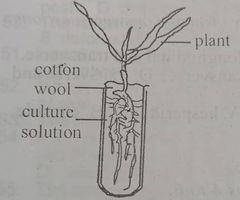
The diagram above is an illustration of the growth of a plant in a water culture. After a few days, the solution turned green and the plant died. Use this to answer this question.
What precaution should have been taken to prevent the solution from turning green?
- A. use a non-green plant for the experiment
- B. aerate the solution daily
- C. cover the culture vessel with opaque paper
- D. keep cotton wool around the seedling to make it dry
An enzyme reaction may begin to decline when?
- A. the optimum temperature is attained
- B. the ph of the medium is altered
- C. there is an increase in substrate concentration
- D. the atmospheric pressure is altered
Which of the following organisms does not undergo incomplete metamorphosis?
- A. locust
- B. grasshopper
- C. butterfly
- D. cockroach


